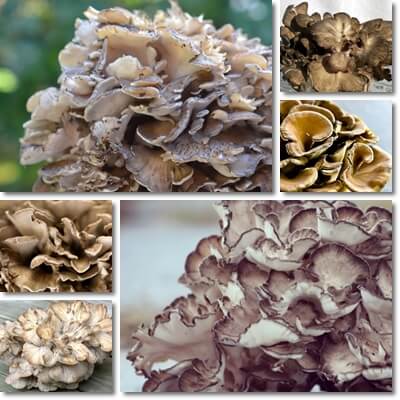Whether you call it by its Japanese name maitake or know it by its more common English name, hen-of-the-woods, Grifola frondosa is a relatively tasty mushroom with good nutrition and a source of important health benefits. The species is a good source of several essential nutrients, notably vitamins B1, B2, B3 and B9, potassium and phosphorus and an excellent source of vitamin D. More important, maitake contains beta-glucans, polysaccharides with immune system modulating activity and exhibits blood sugar-lowering properties. Studies show the mushroom has potential anti-tumor, anti-metastatic and angioegenesis-inhibiting activity, with small scale experiments showing it can activate certain immune system cells, enhance their activity and even induce apoptosis in cancer cells.
What do maitake mushrooms look like? Grifola frondosa, aka maitake, occurs as a cluster of smaller overlapping mushrooms. The caps of individual mushrooms in the cluster are better defined, more visible, while the stems are less discernible as they are covered by the caps. At their base, the individual mushrooms merge into one giant stem. In mature mushrooms, the caps are light brown to tan to smoky brown to gray – the color is not usually uniform and the edges may be either lighter or darker. The underside of the caps and the stems are typically lighter-colored, usually whitish. This is owed to lack of sun exposure as the caps are crowded and offer cover from sunlight. Underneath the caps there are pores through which spores are released.

Maitake is said to look like a flower cluster. For one, the individual mushrooms in the cluster have irregularly shaped, curled caps with wavy or frilled margins that are reminiscent of flower petals. Not to mention they are gathered together in a rather tight bunch, attached somewhere at the base, similar to a cluster of flowers. The mushroom has also been said to look like butterflies in flight. Lastly, as a result of their particular appearance, the caps are said to look like the fluffed up feathers of a hen, hence the alternative name ‘hen of the woods’ for maitake mushrooms.
Are maitake and hen of the woods the same mushroom? Yes, they are, actually. Maitake is the Japanese name for the edible mushroom scientifically known as Grifola frondosa. Hen-of-the-woods, or hen of the woods, is the common English name for the same species. Depending on where you live, you may be using one name or the other. Grifola frondosa extracts or supplements are likely known by the Japanes name, maitake.
What do maitake mushrooms taste like? While taste perception is fairly subjective, maitake is much more savory compared to the more common button mushroom, portobello or crimini (which are rather bland). Overall, it has a mild, but pleasant mushroom taste, with earthy, woody, herbaceous flavor notes. The raw caps are smooth and velvety and the flesh is soft, crisp and succulent, with a slight chewy texture. Older mushrooms become tougher which takes away from the culinary experience.

How to cook maitake
If you were wondering how to cook maitake mushrooms, know they tend to absorb the flavors of stronger-tasting foods they are cooked with. Ideally, maitake should be lightly cooked such as sauteed in butter or olive oil and lightly seasoned (salt, pepper, fresh parsley or some grated Parmigiano-Reggiano). Dry and oil-roasting, grilling and stir-frying are also great ways to enhance their natural flavor. The tough stem holding the individual mushrooms together at the base is best removed. The mushrooms should then be broken into smaller pieces, like you would break broccoli or cauliflower into florets. Gentle washing is recommended, but only prior to cooking.
Maitake recipe ideas to consider:
1) The individual mushrooms and their more tender stems work for: pasta (roasted or sauteed and added to white or whole-wheat spaghetti, with grated Parmesan), rice (classic mushroom risotto), omelettes, pizza (with greens, Parmigiano-Reggiano or other cheeses), mushroom soup (roasting them first enhances the flavor profile), traditional Asian cuisine hot pot dishes. They can be oven roasted with potatoes and other vegetables or grilled to make a meat substitute/vegetarian alternative to steak etc. Pair with onions, ginger, garlic, parsley, thyme, other mushrooms and green vegetables, hard cheeses etc.
2) The stem holding the individual mushrooms together at the base is best removed before cooking, but can be used for making soup or stock. Roasting it first can give it a smoky flavor and enhance the taste profile of the soup/stock.
Where to find maitake/hen-of-the-woods? You can find fresh maitake mushrooms for sale at farmer’s markets or the Asian food market when they’re in season, roughly from late summer and throughout fall. Extracts or supplements of the mushroom are available in health food stores, ethnic food stores and online. If you’re an experienced forager, you can probably find it growing at the base of healthy oak trees or on oak stumps. Chances are it will grow again in the same spot year after year.
Maitake (Grifola frondosa) look-alikes
1) Umbrella polypore, lumpy bracket. Scientific name: Polyporus umbellatus. It is an edible mushroom variety, some say a choice edible, meaning it is particularly savory. It does look a lot like maitake/hen-of-the woods: a bulky-looking cluster made up of sometimes hundreds of smaller mushrooms merged at the base. Cap color is a lighter brown, grayish-brown, while stalks are slightly lighter, a grayish white. The cluster grows from an underground tuber-like structure. Similar to maitake, the umbrella polypore can be found growing on oak and is a pretty close look-alike that could confuse even some experienced foragers.
2) Chicken of the woods. Scientific name: Laetiporus sulphureus. There’s no wonder it’s called chicken-of-the-woods: it looks similar to maitake, aka hen of the woods. However, chicken-of-the-woods grows on the trunk and branches, whereas hen-of-the-woods grows at the base of trees. However, chicken-of-the-woods has a brighter yellow-orangey color (hence the alternative name ‘sulphur polypore’) and the mushrooms are disposed in a shelf-life arrangement (hence the name ‘sulphur shelf’).
Nutrition facts
Research on the nutritional status of Grifola frondosa mushrooms, aka maitake, shows the species to be a good source of the following vitamins and minerals (values for 100 g):
- Potassium: 204 mg out of a recommended daily intake/RDI of 4700 mg (over 4% daily requirements)
- Phosphorus: 74 mg out of an RDI of 700 mg (accounting for 10.5% daily requirements)
- Zinc: 0.75 mg out of an RDI of 11 mg for adult men and 8 mg of adult women (almost 7% of daily requirements of zinc for adult men and around 9.5% for women)
- Vitamin B1: 0.146 mg out of an RDI of 1.2 mg for adult men and 1.1 mg for adult women (an average of 12.5% of daily requirements)
- Vitamin B2: 0.242 mg out of an RDI of 1.3 mg for adult men and 1.1 mg for adult women (accounting for an average of 20% of daily requirements for men and almost 22% for women)
- Vitamin B3: 6.585 mg out of an RDI of 16 mg for adult men and 14 mg for adult women (the equivalent of over 40% of daily requirements for adult men and 47% for women)
- Vitamin B9 (folate): 21 mcg/micrograms out of an RDI of 400 mcg (around 5% of daily requirements)
- Vitamin D: 28.1 mcg/micrograms out of an RDI of 15 mcg (a serving of 100 g accounting for almost double the daily requirements of the vitamin).
- Other nutrition facts: low energetic value (31 kcal/100 g and 22 kcal/per cup/70 g diced mushrooms), good protein and dietary fiber content (1.9 g of protein and 2.7 g of dietary fiber per 100 g).
What are the benefits?
The health benefits of maitake mushrooms, aka hen-of-the-woods, are derived from both a good and varied nutritional profile and the presence of unique compounds such as beta-glucans and D-(+)-trehalose. Potential benefits may include:
- Blood sugar-lowering benefits: attributed to the alpha glucosidase inhibitor D-(+)-trehalose.
- Scientifically proven immune system-modulating activity: beta-glucan polysaccharides in maitake have been shown to stimulate and enhance NK, macrophage and T cell activity as well as antibody response.
- In vitro and animal studies show maitake extract has anti-angiogenesis properties and anti-tumor, anti-metastatic activity, suppressing tumor growth and neutralizing tumor metastasis.
- Preliminary findings show maitake MD-fraction and whole powdered maitake supplementation in cancer patients may have the potential to decrease the size of lung, liver, and breast tumors. Source: Can Maitake MD-Fraction Aid Cancer Patients? by Noriko Kodama, PhD, Kiyoshi Komuta, MD, PhD, and Hiroaki Nanba, PhD. Published in Alt. Med. Review. Vol. 7, No. 3, 2002.
- Vitamin B3 in maitake lowers LDL, high-density lipoprotein, VLDL, very low-density lipoprotein and triglyceride levels.
- Vitamin B3 helps raise HDL, high-density lipoprotein or good cholesterol levels.
- Minor benefits for high blood pressure from small amounts of potassium and low sodium content.
- Benefits for energy metabolism, skin and nervous system from good vitamin B1, B2 and B9 content and generous vitamin B3 content.
- Benefits associated with vitamin D: enhanced immune system response, improved female fertility, better conception rates, better pregnancy outcomes.
- Good food for healthy weight loss thanks to low calorie content and low carbohydrate content.
- Minor benefits for digestion, constipation relief and hemorrhoids management from dietary fiber.
While maitake mushroom extract is supposedly good for cancer as it is under research for its anti-tumor and anti-metastasis properties, owed to a strong immune system-modulating activity, it does not constitute a cancer treatment. At most, it can be used as an adjuvant in immunotherapy, complementing traditional treatment therapies.
What are the side effects?
As with all foods, there are potential side effects associated with maitake consumption, whether the fresh or cooked mushrooms or the mushroom supplements or extracts. These include: allergic reactions with the potential for anaphylactic shock (although rare), gastrointestinal upset if intakes are excessive and interactions with diabetes medication (biologically active compounds exhibiting hypoglycemic effects contribute, together with diabetes medication, to a pronounced reduction in blood sugar levels).
